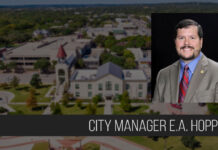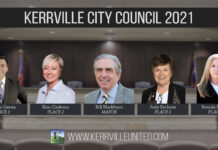The latest set of videos and posts that I published mentioned the voting trends that have become apparent since the new council was elected in May 2017. Rather than speak subjectively about a perceived phenomenon, I elected to study this matter objectively and provide the results to the public.
To be clear, the trends that I had noticed subjectively and wished to study were as follows. These were my hypotheses:
- White, Voelkel, and Baroody tend to vote as a single bloc very consistently.
- Summerlin and Ferguson tend to vote as a single bloc, but not as consistently.
To test those hypotheses, I examined the meeting minutes and the video recordings of every single council meeting held since May 16, 2017. That date was the first meeting that included Place 1 winner Vincent Voelkel and Place 2 winner George Baroody. I did not examine any previous data.
I recorded ALL votes, whether procedural or substantive, so that I did not introduce any subjectivity into this process. Many of the votes here are just to approve the Consent Agenda. Some of the votes are to enter into executive session. But those procedural votes are votes nonetheless, and are counted in this data.
The vote tallies were collected into a single spreadsheet with a record of the date, a description of the motion, and the vote that each candidate cast. Sometimes a councilperson was absent, and their absence was also recorded.
In addition, I made a note about which votes were unanimous, and which were not. A vote was considered unanimous if no member cast a “no” vote. Even if a member was absent, but all four of the remaining members voted “yes,” I recorded that vote as being unanimous, because it’s impossible to predict how an absent member would have voted, and it would have violated our rule of objectivity for this study.
For all votes that were not unanimous, I recorded whether or not each “bloc” voted together, or was split. That is, for any non-unanimous council vote, I asked, “Did the White/Voelkel/Baroody group vote together or split their vote?” and “Did the Summerlin/Ferguson group vote together or split their vote?”
Here are the findings:
- The council voted unanimously 78.7% of the time (59/75).
- The council vote was split on 16 out of 75 votes, or 21.3%.
- The White/Voelkel/Bardoody group voted together on 97.33% of votes taken.
- The Summerlin/Ferguson group voted together on 97.29% of all votes taken.
- When the council vote was NOT unanimous, the White/Voelkel/Baroody bloc voted together 84.6% of the time.
- When the council vote was NOT unanimous, Voelkel and Baroody voted together 14 out of 16 occurrences, or 87.5% of the time.
- When the council vote was NOT unanimous, White and Voelkel voted together 12 out of 13 occurrences, or 92.3% of the time.
- When the council vote was NOT unanimous, Summerlin and Ferguson voted together 13 out of 15 occurrences, or 86.7% of the time.
- Place 3 Mary Ellen Summerlin was absent for one vote that was not unanimous, but her vote (should she have been there to cast it) could not have swayed the outcome of the motion, because that vote was 3-1.
- Mayor Bonnie White was absent for three votes that were not unanimous, and hers would have been the deciding vote in all three instances, because all non-unanimous votes taken during her absence were split 2-2.
- Voelkel, Baroody, and Ferguson have not missed a single vote since May 2017.
I looked more thoroughly into each instance of disagreement among each bloc. I will make a disclaimer here and say that I did choose to introduce a bit of subjectivity from here on, specifically regarding two related votes that were puzzling.
The puzzling votes had to do with the abandonment of an easement on Bluff Ridge Road. Without getting into the weeds, the first vote had Voellkel casting the lone “no” vote, and the rest of council voting yes. This was a motion to draft an agreement to abandon the easement, so clearly Voelkel was against abandonment but the rest of council was for it. But at the next meeting, White, Voelkel, and Baroody all effectively voted against abandonment of that easement. So I examined the voting patterns both with and without that first vote that was puzzling, because at the end of the day, that second vote is what mattered, to me, subjectively, because that was when the vote actually resulted in action (or inaction, in this case).
With that said, here are my somewhat more subjective and specific findings:
Summerlin/Ferguson Bloc
- Summerlin and Ferguson disagreed on whether or not to move the citizens’ forum to the beginning of the meeting on 6/13/17, with Ferguson voting “yes” and Summerlin voting “no.”
- Summerlin and Ferguson disagreed on whether or not to amend City Council Procedural Rule 7.5c on 09/26/2017, with Ferguson voting “yes” and Summerlin voting “no.”
- Each of these two issues came before council only once during this period.
White/Voelkel/Baroody Bloc
- Mr. Voelkel was the lone “no” vote on a motion to instruct city staff to draft an abandonment document for an easement on Bluff Ridge on 06/27/17. White and Baroody each voted “yes,” along with Summerlin and Ferguson.
- However, that issue came back before the council again on 7/25/17, and that time the bloc voted together, quashing the motion 3-2.
- Mr. Baroody was the lone “no” vote on a motion to approve the KCAD budget on 08/08/2017 that passed 4-1. That issue did not come before council a second time.
Conclusions
- The vast majority of votes cast were unanimous — about 72%.
- If you disregard the 06/13/17 vote regarding the Bluff Trails easement (since the matter came back before the council and each bloc voted together for the deciding vote), the White/Voelkel/Baroody bloc voted together 98.6% of the time — 66 of 67 opportunities.
- Disregarding that same Bluff Trails initial vote (same reason stated above), Voelkel and White voted together 100% of the time — 67 out of 67.
- The Summerlin/Ferguson bloc voted together 97.3% of the time — 72 out of 74 opportunities, but only 86.7% of the time when the council vote as a whole was not unanimous.
- Our first hypothesis was correct: each bloc votes together on an overwhelming majority of votes taken.
- Our second hypothesis was correct: the White/Voelkel/Baroody bloc votes together at a higher rate than the Summerlin/Ferguson bloc, whether or not you include the Bluff Trails easement issue, especially when the overall council vote is not unanimous.
Here is the raw data that we compiled for this discussion:




